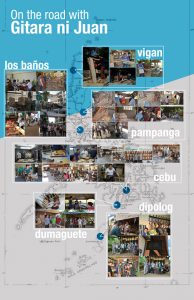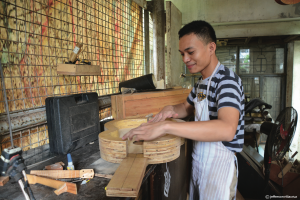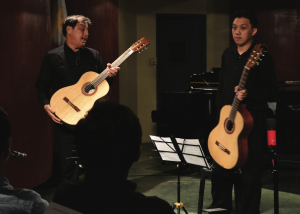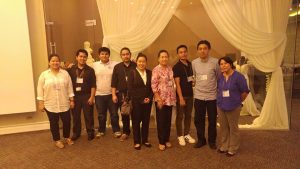 A team of faculty members, engineers and musicians from UP Diliman combined art, engineering and science to create a quality classical guitar for Juan Dela Cruz and which may hopefully revive the declining industry of guitar-making in the Philippines.
A team of faculty members, engineers and musicians from UP Diliman combined art, engineering and science to create a quality classical guitar for Juan Dela Cruz and which may hopefully revive the declining industry of guitar-making in the Philippines.
Gitara ni Juan (GnJ) project. The UP College of Music (CMu), in collaboration with the College of Engineering Electrical and Electronics Engineering Institute (COE-EEEI) started the 18-month project “Gitara ni Juan: Development of prototype design and standardization of the guitar-making process for quality classical guitars using select Philippine woods,” in December 2014 to “establish a standard for the entry-level classical guitar-making process in the country.”
With more than 3,000 species of Philippine woods, the GnJ project also sought to explore and promote the use of locally available woods as alternatives “by incorporating them into guitar prototypes.”
According to the project team, “most high-quality guitars available in the market use imported solid woods such as spruce, cedar, or rosewood.”
The project was funded by Philippine Council for Industry, Energy, and Emerging Technology Research and Development of the Department of Science and Technology (DOST-PCIEERD).
Prof. Nathan Manimtim, current CMu Department of Strings and Chamber Music chair, is the project leader and the two other proponents are COE instructors Crisron Rudolf Lucas of EEEI and Jon Dewitt Dalisay of the Department of Mechanical Engineering (DME).
Other members of the team are researchers Engr. Ivan Nikolai Reyes (EEEI), Adel Isabelle Sta. Maria (DME) and Bernice Elaine Go (CMu); and administrative personnel Eva Cadiz, Mylene Untalan and Virgilio Liboon.
The project consultants are CMu dean Dr. Jose Buenconsejo, EEEI professors Dr. Rhandley Cajote and Dr. Franz De Leon; Engr. Josephine Carandang and forester Robert Natividad of DOST Forest Products Research and Development Institute (DOST-FPRDI), Master Luthier Adolfo Timuat, a Filipino-Spanish guitar maker, and luthier Kently Morales, a guitar maker from Pampanga.
In an interview with UPDate, Manimtim said it was the first time that the college collaborated with two COE departments and handled a project funded by the DOST-PCIEERD.
He said the project was a result of the talks in 2013 between CMu Dean Buenconsejo and Dr. Rowena Guevara, DOST Undersecretary and former COE dean, about a multidisciplinary project on instrument making.
 The making of Gitara ni Juan. With a budget of almost P5 million, the team visited guitar making sites in the Philippines for the first phase of the project and met most of the luthiers (stringed instrument makers).
The making of Gitara ni Juan. With a budget of almost P5 million, the team visited guitar making sites in the Philippines for the first phase of the project and met most of the luthiers (stringed instrument makers).
Lucas, who is an expert in digital signal processing, said the team worked on finding the inconsistent qualities in locally-made entry-level guitars and plans to recommend to the backyard luthiers the standard process of and the use of local woods in making guitars.
An entry-level guitar is a beginner or student-level guitar. A recital-level guitar is mostly used by those studying in music institutions while concert-level guitars are used by professional guitarists.
Manimtim, on the other hand, said the use of spruce and rose wood for quality guitars are quite expensive “Kaya ang nangyari doon sa local makers natin, gumagamit sila ng plywood at saka ng ibang mga mumurahing wood para makagawa ng gitara. Ang nangyayari, nasa-sacrifice iyong quality.”
He said the use of local woods in making instruments was based on the previous research of Carandang in the late ‘80s.
“May gina-wang application ng research si Carandang from FPRDI noong late ‘80s. Gumawa talaga sila ng guitar using those local woods na tinest din dito sa CMu. Iyun ang simula ng research na ganito,” he said.
During the team’s data gathering in Dumaguete City, they met William and his brother Jayson Alama and requested them to be the official project luthiers.
William is a 27-year-old guitar maker from Dauin, Dumaguete City, Negros Oriental. He learned the skill of making instruments from his late grandfather who was a known luthier in their province. When better-built imported guitars became a popular choice among Filipino musicians, the market for Philippine-made guitars considerably declined, forcing most guitar makers to shift to more sustainable jobs in order to survive.
Through the help of his brother, William created the 12 prototype guitars based on the “recipe” given by the team.
Dalisay, who teaches mechanical engineering subjects at the COE, said these prototypes were made from different combinations of wood. He said there are two general classifications of wood used in guitar parts: soft and hard.
 Dalisay said specific woods were used for the soft and hard wood parts of the prototype guitars. The team also replicated the prototypes to test the variability between two guitars with the same combination of wood.
Dalisay said specific woods were used for the soft and hard wood parts of the prototype guitars. The team also replicated the prototypes to test the variability between two guitars with the same combination of wood.
“All the other things, iyung geometry, manufacturing, of course, pare-parehas na between the guitars. Iyung naging main purpose, iyung main na inaral doon sa gitara ay kung ano iyung combination ng wood na, let’s say, pinakamaganda in terms of sound quality, playability, intonation, etc.,” Dalisay said.
Meanwhile, Manimtim said the team tested the prototype guitars qualitatively and quantitatively.
“Iyung qualitative (testing), sa aming mga musician gaya ng listening at playing tests. Iyung quantitative tests naman ay ginawa ng mga engineer tulad ng paggamit ng MIRtoolbox, Chladni at accelerometer tests, finite element analysis (FEA), at iba pa,” he said.
The team also explored many methodologies throughout the course of the project; in particular, they used X-ray on the musical instruments with the help of doctors at the National Kidney and Transplant Institute. The team said “Though it is already an established methodology abroad, it is the first time that it was intensively applied in the Philippines.”
The team said “This project also opened up a new approach in signal analysis done in UP Diliman, where subjective evaluations from human sound perception tests are linked to quantifiable audio features and properties which are then linked to material properties and modal vibration models.”
At the GnJ’s official launch at the CMu Mini Hall on May 12, one of the prototype entry-level guitars was played by Prof. Lester Demetillo, an esteemed classic guitarist in the Philippines.
Manimtim said “Iyung guitar, lumampas sa level na kailangan lang or sa aming proposal na entry level. Umabot siya sa recital level or college student guitar sabi ni Prof. Demetillo.”
 Updates on the project. This year, the project is technically finished and the team is currently preparing its final output.
Updates on the project. This year, the project is technically finished and the team is currently preparing its final output.
Lucas said the next step is to make a compendium (manual).
“Iyung goal ng project is standardization at para makarating ito sa mga target namin na benefactors, siyempre kailangan namin ng compendium. Ang next challenge ay kung paano natin ipapasunod ang compendium sa mga luthier, dahil may mga kanya-kanyang trade secret sila. Tapos ngayon, since after years of making guitars, paano sila susunod sa bagong standard which is backed up with science and engineering?” he added.
According to Manimtim, the team is planning to propose a project that will upgrade the prototype entry-level guitars into recital or concert-level guitars.
Manimtim also said UP allocated funds to CMu for the construction of a new building that will be “designated as an instrument making room. I think the dean is also planning to have this program. Siguro magsisimula sa extension program na we will be offering this instrument making non-credit courses. Baka tayo (ang UP Diliman) ang mauna. Sana.”
Reviving guitar-making in the Philippines. Manimtim said “Gusto naming tulungan ang guitar makers natin. During our trips, nakita namin kung gaano kagaling ang mga kababayan natin. Pero sayang iyung craftsmanship na iyon kung hindi natin matuturuan kung papaano gagawing tama iyung gitara.”
From the data gathered, the team also discovered that most guitar makers in the country already shifted to another job.
Manimtim said “May makers na nangisda na at nagtatrabaho na bilang waiter. Umalis sila sa paggawa ng gitara kasi wala ng masyadong bumibili na kababayan natin ng gawa nila. Sa mga malalaking malls na aming binisita sa Metro Manila at mga probinsiya upang tingnan ang mga gitara sa mga music store, halos wala kaming napansin na naka-display o itinitindang gawang lokal na gitara, nakakalungkot kasi puro imported na.”
Through the GnJ project, the team members are hoping to help local luthiers like William to revive the industry and produce high quality guitars at par with its foreign counterparts.
Gitara ni Juan was showcased at DOST’s National Science and Technology week from Jul. 24-28, 2015 and Jul. 25-28, 2016 at the SMX Convention Center, Pasay City and Bicutan Science Community, DOST Complex, Bicutan, Taguig City, respectively.
It was also presented at the DOST-PCIEERD’s 6th anniversary in Clark, Pampanga on Jun. 29 where four of the 12 prototypes were presented and played during the event. The team also conducted a “Guitar Making Clinic” attended by guitar makers from Pampanga, Cebu, Dumaguete and Dipolog.—with photos from the GnJ project team
Photo caption: (Top to bottom) Research map of Gitara ni Juan (GnJ); William Alama, luthier from Dumaguete; Prof. Lester Demetillo (left) with GnJ project leader Prof. Nathan Neil Manimtim; and the GnJ project team with Engr. Josephine Carandang (fourth from right).
